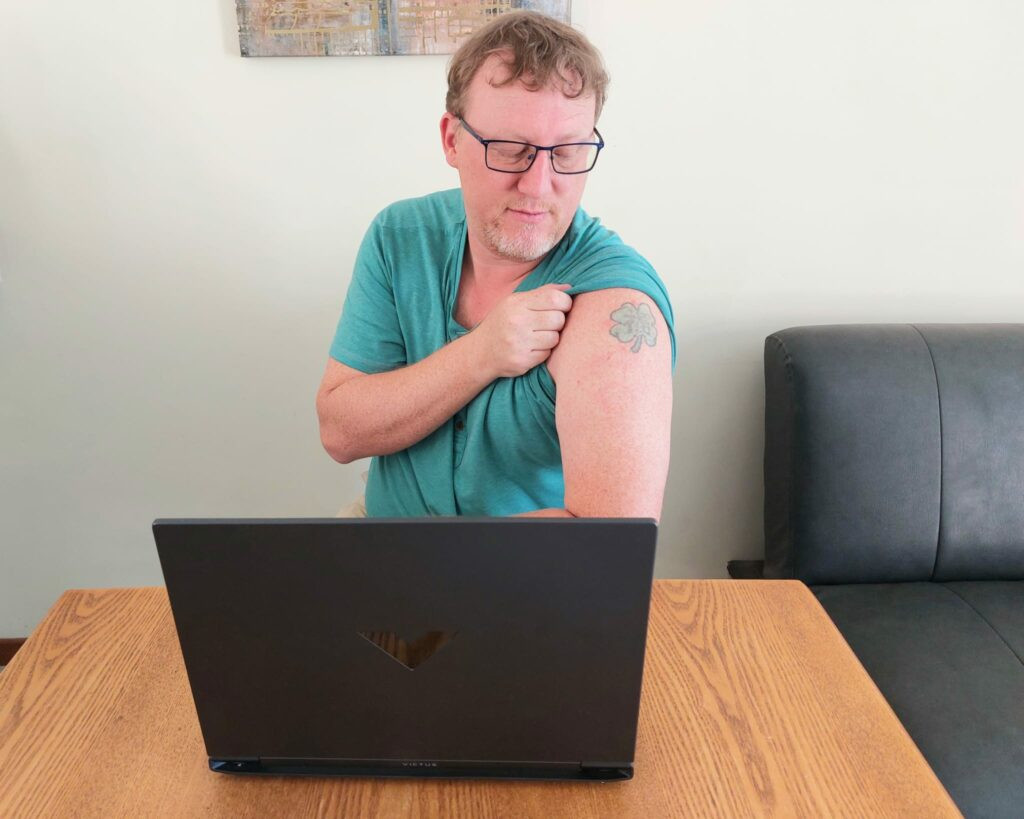Can Teachers Have Tattoos In Florida? Absolutely, teachers in Florida can have tattoos, but navigating the policies surrounding visible body art requires careful consideration. At tattooat.com, we understand the importance of self-expression through tattoos, but also the need to adhere to professional standards. Let’s explore the specifics of tattoo policies for educators in Florida, ensuring you can confidently express yourself while maintaining a successful teaching career, providing you resources for tattoo designs, tattoo artists and information on body art.
In this article, we will address the concerns of educational institutions about the relationship between tattoos and teaching to clear the way for tattoo acceptance in the workplace.
1. Tattoo Policies for Teachers in Florida: What You Need to Know
What exactly are the rules about teachers having tattoos in Florida? It’s crucial for educators and aspiring teachers to be aware of the regulations regarding visible tattoos in the state.
The short answer is that Florida does not have a statewide law specifically prohibiting teachers from having tattoos. However, the lack of a statewide regulation doesn’t mean there are no restrictions. Individual school districts and even specific schools within those districts often have their own policies regarding employee appearance, and these policies can include guidelines on tattoos.
These policies can range from being quite lenient, allowing visible tattoos as long as they are not offensive or distracting, to being very strict, requiring all tattoos to be covered at all times. Some schools may require that any tattoos be covered up if they are considered offensive or obscene. Additionally, some schools may ask you to cover up your tattoos if they feel that they could be a distraction to your students.
For example, a school district policy might state that “all staff members must maintain a professional appearance, and any visible tattoos must be covered if they are deemed inappropriate or distracting to the learning environment.”
It is important to thoroughly research the school’s policy before getting one. To ensure compliance, teachers should:
- Review the District’s Policy: Begin by thoroughly reviewing the school district’s official policy on employee appearance and tattoos.
- Consult the HR Department: Reach out to the Human Resources (HR) department for clarification on any ambiguous aspects of the policy.
- Observe the School Culture: Pay attention to the prevailing culture and norms within the specific school where you plan to work.
- Seek Guidance from Senior Staff: Consult with experienced teachers or administrators to gain insights into how tattoos are perceived and handled in practice.
- Consider Tattoo Placement: Choose tattoo placements that can be easily covered with professional attire if needed.
- Opt for Appropriate Designs: Select tattoo designs that are generally considered non-offensive and suitable for a school environment.
- Document Everything: Keep a record of all communications with HR or school authorities regarding tattoo policies.
- Stay Informed: Stay updated on any changes or updates to the school district’s policies on tattoos.
By following these steps, teachers can confidently navigate tattoo policies in Florida’s education system, ensuring compliance while expressing their individuality responsibly.
Navigating these policies requires careful research and understanding of the specific school or district where you plan to work.
 Teacher with flower tattoo on arm
Teacher with flower tattoo on arm
Alt text: A teacher’s forearm features a beautiful, intricate flower tattoo, showcasing a blend of personal expression and professional identity.
2. Legal Aspects: Discrimination and Tattoos in the Workplace
Are teachers protected from discrimination based on their tattoos? Let’s delve into the legal landscape surrounding tattoos and employment in Florida.
Unfortunately, in Florida, there are limited legal protections against discrimination based on tattoos in the workplace. The Equality Act primarily addresses discrimination related to factors like sexual orientation or gender, and does not extend to tattoos. This means that school boards, districts, and individual schools technically have the right to implement policies that may discriminate against teachers and other teaching professionals based on their tattoos.
Despite the lack of specific legal protection, there may be some instances where a discrimination claim could be made. For example, if a school’s tattoo policy is applied inconsistently or unfairly, targeting certain individuals or groups, it could potentially be argued as a form of discrimination.
Furthermore, if a teacher’s tattoo is related to a protected characteristic, such as religious beliefs or cultural heritage, then discrimination based on that tattoo may be subject to legal challenges.
However, in most cases, employers in Florida have the legal right to enforce appearance standards, including those related to tattoos, as long as they are applied reasonably and consistently.
It’s worth noting that while legal protections may be limited, societal attitudes towards tattoos are evolving, and many employers are becoming more accepting of visible tattoos, particularly if they are not offensive or distracting.
Therefore, it is important for teachers to be aware of their rights and responsibilities when it comes to tattoos in the workplace, and to seek legal advice if they believe they have been unfairly discriminated against.
3. The Pros and Cons: Tattoos in the Teaching Profession
What are the advantages and disadvantages of having tattoos as a teacher? Consider both the professional and personal aspects of this decision.
3.1. Advantages of Having a Tattoo as a Teacher
Having a tattoo as a teacher can bring several unexpected benefits to the classroom and beyond.
Tattoos do not affect job performance and do not impede a teacher’s ability to educate and connect with students.
-
Enhanced Student Connections:
- Tattoos can serve as conversation starters, allowing teachers to connect with students on a more personal level.
- Sharing the stories behind their tattoos can help teachers build rapport and establish trust with students.
-
Increased Approachability:
- Visible tattoos can make teachers seem more approachable and relatable, especially to students who may also have tattoos or be interested in body art.
- Teachers with tattoos may be perceived as more open-minded and accepting, creating a more inclusive classroom environment.
-
Self-Expression and Authenticity:
- Tattoos allow teachers to express their individuality and showcase their personality in a unique and creative way.
- Being authentic and genuine can help teachers build stronger relationships with students, as they are seen as real people with diverse interests and experiences.
-
Modernized Image:
- In an increasingly tattoo-accepting society, having visible tattoos can help teachers appear more modern and in touch with current trends.
- This can be particularly beneficial in engaging younger students who may view tattoos as a form of self-expression and creativity.
-
Educational Opportunities:
- Tattoos can be used as a teaching tool, sparking discussions about art, culture, history, and personal expression.
- Teachers can use their tattoos to teach students about the importance of respecting diversity and celebrating individuality.
Overall, having a tattoo as a teacher can enhance student connections, increase approachability, promote self-expression, modernize the teacher’s image, and provide unique educational opportunities.
 Teacher with handshake and tattoo
Teacher with handshake and tattoo
Alt text: A teacher and student share a handshake, with the teacher’s wrist tattoo visible, symbolizing connection and relatability.
3.2. Disadvantages of Having a Tattoo as a Teacher
Despite the potential benefits, there are also several potential drawbacks to consider before getting a tattoo as a teacher.
-
Potential for Offense or Misinterpretation:
- Tattoos can be misinterpreted or considered offensive by some students, parents, or colleagues, leading to discomfort or negative perceptions.
- Tattoo designs or symbols may have different meanings to different people, potentially causing misunderstandings or conflicts.
-
Unprofessional Appearance:
- In some conservative or traditional school environments, visible tattoos may be seen as unprofessional or inappropriate for a teacher.
- Tattoos may challenge established norms and expectations, leading to judgment or disapproval from administrators or community members.
-
Distraction in the Classroom:
- Tattoos, especially those with intricate designs or vibrant colors, may distract students from their learning activities.
- Students may become more focused on the teacher’s tattoos than on the lesson being taught, hindering their ability to concentrate and absorb information.
-
Limited Job Opportunities:
- In certain school districts or private schools, strict appearance policies may limit job opportunities for teachers with visible tattoos.
- Teachers may face discrimination or bias during the hiring process due to their tattoos, even if they are qualified and experienced.
-
Need for Cover-Up:
- Teachers with tattoos may be required to cover them up during school hours, which can be inconvenient or uncomfortable.
- Covering tattoos may involve wearing specific clothing items or using makeup, adding extra time and effort to the teacher’s daily routine.
Overall, potential disadvantages include the risk of causing offense or misinterpretation, projecting an unprofessional image, creating distractions in the classroom, limiting job opportunities, and the need to cover up tattoos. Weighing these pros and cons is essential for teachers considering getting inked.
4. Tattoo Styles and Placement: Making the Right Choices
How do the type and location of a tattoo affect its perception in a school setting? This section offers guidance on making appropriate choices.
4.1. Choosing Appropriate Tattoo Styles for Teachers
When it comes to selecting a tattoo style as a teacher, it’s crucial to consider the potential impact on students, parents, and colleagues.
-
Positive and Inspirational Designs:
- Opt for tattoo designs that promote positivity, inspiration, and personal growth.
- Consider symbols of knowledge, wisdom, or creativity to align with the teaching profession.
-
Nature-Inspired Imagery:
- Choose nature-inspired tattoos, such as flowers, trees, or animals, to evoke a sense of tranquility and connection with the natural world.
- These designs can be visually appealing and generally considered non-offensive in most school environments.
-
Abstract and Artistic Expressions:
- Explore abstract tattoo styles that showcase artistic expression without explicit or controversial imagery.
- Abstract designs can add a touch of creativity and individuality while remaining open to interpretation.
-
Meaningful Quotes or Words:
- Select meaningful quotes or words that resonate with your values and beliefs as an educator.
- Ensure that the chosen words are appropriate for a school setting and convey a positive message.
-
Cultural or Heritage Symbols:
- Consider incorporating cultural or heritage symbols that represent your background or ancestry.
- Be mindful of the potential for misinterpretation and choose symbols that are widely recognized and respected.
-
Avoid Controversial or Offensive Imagery:
- Steer clear of tattoo designs that may be considered controversial, offensive, or inappropriate for a school environment.
- Avoid imagery related to violence, drugs, alcohol, or any content that could be seen as disrespectful or discriminatory.
By carefully selecting tattoo styles that align with positive values, artistic expression, and cultural sensitivity, teachers can confidently showcase their individuality while maintaining a professional image.
4.2. Ideal Tattoo Placement for Teachers
Choosing the right placement for a tattoo is essential for teachers who want to balance self-expression with professional expectations.
-
Discreet Locations:
- Opt for tattoo placements that can be easily covered with professional attire, such as the upper arm, shoulder, back, or thigh.
- These locations allow teachers to reveal or conceal their tattoos as needed, depending on the school’s policies and the specific situation.
-
Forearm or Wrist:
- Consider the forearm or wrist as placement options, as they can be visible or covered with long sleeves or accessories.
- Smaller tattoos in these areas can be a subtle way to showcase individuality while remaining relatively discreet.
-
Ankle or Foot:
- Choose the ankle or foot for tattoos that are easily concealed with socks or shoes, providing flexibility and control over visibility.
- These placements are ideal for teachers who want to express themselves without drawing excessive attention.
-
Avoid Highly Visible Areas:
- Refrain from getting tattoos on highly visible areas such as the face, neck, or hands, as these may be considered unprofessional in some school settings.
- These placements are generally more challenging to cover and may attract unwanted attention or judgment.
-
Consider Tattoo Size:
- Think about the size of the tattoo in relation to its placement, opting for smaller designs that can be easily hidden if necessary.
- Larger tattoos may require more extensive cover-up measures, which can be inconvenient and time-consuming.
-
Test Visibility:
- Before getting a tattoo, test its visibility with different clothing options to ensure that it can be effectively concealed when required.
- This can help teachers make informed decisions about tattoo placement and avoid potential conflicts with school policies.
By carefully considering tattoo placement and opting for discreet locations, teachers can confidently express themselves while adhering to professional standards.
 Tattoo on arm of teacher in suit
Tattoo on arm of teacher in suit
Alt text: A teacher in a professional suit reveals a tasteful tattoo on their arm, balancing personal expression with workplace decorum.
5. Navigating School Culture: Perception and Acceptance
How can teachers gauge and adapt to the tattoo culture within their school environment? Here are some strategies for navigating these waters.
5.1. Assessing the School’s Tattoo Culture
Before making any decisions about visible tattoos, it’s essential for teachers to assess the prevailing tattoo culture within their school environment.
-
Observe Staff Members:
- Pay attention to whether other staff members have visible tattoos and how they are perceived by colleagues and administrators.
- This can provide insights into the general acceptance of tattoos within the school community.
-
Review School Policies:
- Carefully review the school’s official policies regarding employee appearance, including any guidelines on tattoos.
- Understand the specific rules and regulations that may apply to teachers with visible body art.
-
Attend School Events:
- Attend school events, such as staff meetings, parent-teacher conferences, and school-wide celebrations, to gauge the overall atmosphere and attitudes towards tattoos.
- Observe how tattoos are perceived and discussed in these settings.
-
Talk to Senior Staff:
- Reach out to experienced teachers or administrators to inquire about their perspectives on tattoos and any potential concerns.
- Seek guidance on how to navigate tattoo-related issues and maintain a professional image.
-
Consider Community Demographics:
- Take into account the demographics of the school community, including the cultural and religious backgrounds of students and parents.
- Understand that some communities may have more conservative views on tattoos than others.
-
Be Mindful of School Traditions:
- Be aware of any long-standing traditions or customs within the school that may influence perceptions of tattoos.
- Respect the school’s history and adapt your approach accordingly.
By carefully assessing the school’s tattoo culture through observation, policy review, and consultation with senior staff, teachers can make informed decisions about how to express themselves while respecting the norms and expectations of their workplace.
5.2. Strategies for Promoting Acceptance
If teachers find themselves in a school environment where tattoos are not widely accepted, there are several strategies they can employ to promote greater understanding and acceptance.
-
Lead by Example:
- Demonstrate professionalism, competence, and dedication in your role as a teacher, allowing your skills and character to speak for themselves.
- Show that tattoos do not define your abilities or commitment to your students.
-
Engage in Open Dialogue:
- Initiate conversations with colleagues, parents, and students about the meaning and significance of tattoos, sharing your personal stories and perspectives.
- Encourage open and respectful discussions to dispel misconceptions and promote understanding.
-
Educate and Inform:
- Provide educational resources about the history, culture, and artistry of tattoos, showcasing their diverse and meaningful aspects.
- Share articles, documentaries, or presentations that highlight the positive contributions of tattooed individuals.
-
Highlight Role Models:
- Showcase examples of successful professionals, artists, or community leaders who have tattoos and are respected for their achievements.
- Emphasize that tattoos do not hinder one’s ability to excel in their chosen field.
-
Respect Diverse Views:
- Acknowledge that not everyone may share your enthusiasm for tattoos and respect their right to hold different opinions.
- Avoid being defensive or dismissive of concerns, and instead, listen with empathy and understanding.
-
Collaborate with Allies:
- Seek out like-minded individuals within the school community who support self-expression and diversity.
- Work together to organize events, workshops, or discussions that celebrate individuality and promote acceptance of tattoos.
By leading by example, engaging in open dialogue, educating others, highlighting role models, respecting diverse views, and collaborating with allies, teachers can play a significant role in fostering a more inclusive and accepting school environment for themselves and others.
6. Online Teaching: A More Tattoo-Friendly Environment?
Does the rise of online education offer more freedom for teachers with tattoos? Let’s explore the unique considerations of this digital landscape.
6.1. Advantages of Online Teaching for Tattooed Teachers
Online teaching can provide a more accommodating environment for teachers with tattoos, offering several advantages over traditional classroom settings.
-
Greater Flexibility:
- Online teachers often have greater flexibility in terms of dress code and appearance, as they are not bound by the same strict standards as those in physical schools.
- This allows teachers with tattoos to express themselves more freely without fear of judgment or discrimination.
-
Control over Visual Presentation:
- Online teachers have greater control over their visual presentation during virtual lessons, allowing them to strategically showcase or conceal their tattoos as desired.
- They can use clothing, camera angles, or digital backgrounds to manage the visibility of their tattoos and create a professional image.
-
Focus on Skills and Expertise:
- In online teaching environments, there is often a greater emphasis on skills, expertise, and teaching effectiveness rather than physical appearance.
- Tattoos are less likely to be a distraction or a point of contention, as the focus is primarily on the quality of instruction and student engagement.
-
Global Reach:
- Online teaching platforms often attract a diverse student population from around the world, with varying cultural perspectives on tattoos.
- This can create a more accepting and inclusive learning environment for teachers with tattoos.
-
Reduced Face-to-Face Interaction:
- The reduced face-to-face interaction in online teaching can minimize the potential for negative perceptions or stereotypes based on tattoos.
- Teachers can connect with students primarily through their virtual presence and online interactions, which can help to build trust and rapport based on their skills and knowledge.
-
Opportunities for Self-Expression:
- Online teaching provides unique opportunities for teachers to express their individuality and creativity through their online persona, including their virtual backgrounds, digital avatars, and teaching style.
- Tattoos can be incorporated as part of their overall online presence, allowing them to connect with students on a more personal level.
Overall, online teaching can provide a more tattoo-friendly environment for teachers, offering greater flexibility, control over visual presentation, and a focus on skills and expertise.
6.2. Considerations for Maintaining Professionalism Online
While online teaching may offer more freedom, it’s still important for tattooed teachers to maintain a professional image.
-
Be Mindful of Audience:
- Consider the age, cultural background, and expectations of your students when deciding whether to display your tattoos during online lessons.
- Adapt your approach based on the specific needs and preferences of your audience.
-
Maintain a Clean and Organized Workspace:
- Ensure that your workspace is clean, organized, and free from distractions, regardless of whether your tattoos are visible or not.
- Create a professional and inviting environment that fosters learning and engagement.
-
Dress Appropriately:
- Dress professionally and appropriately for your online lessons, taking into consideration the norms and expectations of the teaching profession.
- Choose clothing that is clean, well-fitting, and free from offensive or distracting imagery.
-
Communicate Clearly and Respectfully:
- Communicate clearly, respectfully, and professionally with your students, colleagues, and parents, regardless of your appearance.
- Focus on building positive relationships and fostering a supportive learning environment.
-
Follow School Policies:
- Be aware of and adhere to any school or district policies regarding employee appearance, even in the online setting.
- Consult with your supervisor or HR department if you have any questions or concerns about tattoo-related issues.
-
Prioritize Student Learning:
- Always prioritize student learning and well-being above all else, regardless of your personal choices or preferences.
- Ensure that your appearance does not distract from or detract from the learning experience for your students.
By being mindful of their audience, maintaining a professional workspace, dressing appropriately, communicating respectfully, following school policies, and prioritizing student learning, tattooed teachers can confidently navigate the online teaching landscape while upholding the highest standards of professionalism.
 Teacher with tattoo in zoom
Teacher with tattoo in zoom
Alt text: An online teacher reveals a stylish tattoo during a Zoom session, demonstrating how to balance personal expression with digital professionalism.
7. Resources and Support for Tattooed Teachers
Where can teachers find more information and support related to tattoo policies and workplace issues? Here are some helpful resources:
7.1. Organizations and Websites
Several organizations and websites offer valuable information and support for tattooed individuals in the workplace, including teachers.
-
Tattoo-Friendly Workplace Initiatives:
- Look for organizations that promote tattoo acceptance and inclusion in the workplace.
- These initiatives may provide resources, training, and advocacy for tattooed employees.
-
Legal Aid Societies:
- Consult with legal aid societies or employment law attorneys for advice on your rights and protections as a tattooed employee.
- They can provide guidance on discrimination issues and help you navigate complex legal situations.
-
Professional Associations:
- Connect with professional associations in your field to learn about industry-specific policies and norms regarding tattoos.
- These associations may offer resources, networking opportunities, and advocacy for their members.
-
Online Forums and Communities:
- Join online forums and communities dedicated to tattoos and workplace issues to connect with other tattooed professionals and share experiences.
- These platforms can provide support, advice, and a sense of community.
-
Human Resources Departments:
- Reach out to your employer’s human resources department for clarification on tattoo policies and guidance on workplace issues.
- HR professionals can provide information on your rights and responsibilities as an employee.
-
Tattoo Advocacy Groups:
- Support tattoo advocacy groups that work to challenge discriminatory practices and promote tattoo acceptance in society.
- These groups may organize events, campaigns, and educational initiatives to raise awareness and change perceptions.
- Visit tattooat.com to explore various designs and artists
7.2. Tips for Advocating for Yourself
If you encounter discrimination or unfair treatment due to your tattoos, here are some tips for advocating for yourself.
-
Know Your Rights:
- Familiarize yourself with the laws and policies in your area regarding discrimination based on appearance.
- Understand your rights as an employee and be prepared to assert them if necessary.
-
Document Everything:
- Keep a detailed record of any incidents of discrimination or unfair treatment, including dates, times, locations, and witnesses.
- Document any communication with your employer or HR department regarding tattoo-related issues.
-
Seek Legal Advice:
- Consult with an employment law attorney to discuss your options and determine the best course of action.
- An attorney can help you understand your rights and navigate the legal process.
-
File a Complaint:
- If you believe you have been discriminated against, consider filing a formal complaint with your employer or a government agency.
- Follow the proper procedures and provide all necessary documentation to support your claim.
-
Negotiate a Resolution:
- Attempt to negotiate a resolution with your employer, such as a change in policy or a commitment to address the issue.
- Be prepared to compromise and find a solution that is fair and equitable for all parties involved.
-
Seek Support:
- Reach out to friends, family, or support groups for emotional support and encouragement.
- Surround yourself with people who understand and appreciate your individuality.
By knowing your rights, documenting everything, seeking legal advice, filing a complaint, negotiating a resolution, and seeking support, you can effectively advocate for yourself and challenge discriminatory practices in the workplace.
8. Staying Updated: Tattoo Trends and Cultural Shifts
How can teachers stay informed about evolving tattoo trends and cultural shifts related to body art? Here are some strategies for staying in the know:
8.1. Following Tattoo Industry News
Staying informed about the latest tattoo industry news is essential for teachers who want to remain knowledgeable about evolving trends and cultural shifts.
-
Read Tattoo Magazines and Blogs:
- Subscribe to reputable tattoo magazines and blogs to stay updated on new styles, techniques, and artists.
- These publications often feature articles on tattoo culture, history, and social issues.
-
Attend Tattoo Conventions and Events:
- Attend tattoo conventions and events to see the latest designs, meet artists, and learn about new trends.
- These events provide opportunities to network with other tattoo enthusiasts and industry professionals.
-
Follow Tattoo Artists on Social Media:
- Follow tattoo artists on social media platforms to see their latest work and get insights into their creative process.
- Engage with artists and ask questions to learn more about their techniques and influences.
-
Watch Tattoo-Related Documentaries and TV Shows:
- Watch documentaries and TV shows that explore the world of tattooing, including its history, culture, and artistry.
- These programs can provide valuable insights into the diverse perspectives and practices within the tattoo community.
-
Participate in Online Discussions:
- Join online discussions and forums dedicated to tattoos to share your thoughts, ask questions, and learn from others.
- Engage in respectful and informed conversations to broaden your understanding of tattoo-related issues.
-
Visit Tattoo Studios and Galleries:
- Visit local tattoo studios and galleries to see the work of different artists and learn about their styles and specialties.
- Talk to artists and staff to get their perspectives on current trends and cultural shifts.
8.2. Understanding Cultural Perceptions of Tattoos
Gaining a comprehensive understanding of cultural perceptions of tattoos is crucial for teachers who want to navigate the social and professional landscape with sensitivity and awareness.
-
Research Cultural History:
- Research the historical and cultural significance of tattoos in different societies around the world.
- Learn about the origins, meanings, and symbolism associated with various tattoo styles and traditions.
-
Explore Religious Perspectives:
- Explore religious perspectives on tattoos, as some religions may have specific beliefs or prohibitions regarding body art.
- Understand how religious views may influence attitudes towards tattoos in certain communities.
-
Consider Generational Differences:
- Consider generational differences in attitudes towards tattoos, as younger generations may have more accepting views than older generations.
- Be aware of how generational perspectives may shape workplace dynamics and social interactions.
-
Engage with Diverse Communities:
- Engage with diverse communities and individuals to learn about their personal experiences with tattoos and their perceptions of body art.
- Listen with empathy and respect to gain a deeper understanding of different cultural perspectives.
-
Be Mindful of Context:
- Be mindful of the context in which tattoos are displayed, as certain settings or situations may call for more discretion than others.
- Adapt your approach based on the specific cultural norms and expectations of the environment.
-
Promote Respect and Understanding:
- Promote respect and understanding for diverse cultural perspectives on tattoos by encouraging open dialogue, sharing information, and challenging stereotypes.
- Foster a culture of inclusivity and acceptance where individuals feel comfortable expressing themselves without fear of judgment or discrimination.
9. FAQ: Tattoos and Teaching in Florida
Here are some frequently asked questions about tattoos and teaching in Florida, providing quick answers to common concerns:
9.1. Can I be denied a teaching job in Florida because of my tattoos?
Potentially, yes. While there is no statewide law prohibiting teachers from having tattoos, individual school districts and schools can set their own appearance policies. If a visible tattoo violates these policies, it could affect your job prospects.
9.2. What types of tattoos are generally considered unacceptable in Florida schools?
Tattoos that are offensive, obscene, or promote violence, drugs, or discrimination are generally considered unacceptable. The specific interpretation can vary by school district.
9.3. Do I have to cover up my tattoos if I am a teacher in Florida?
It depends on the school’s policy. Some schools may require all tattoos to be covered, while others may only require the covering of tattoos deemed inappropriate.
9.4. Can I express my religious or cultural beliefs through tattoos as a teacher in Florida?
Potentially, yes, but it depends on the specific tattoo and the school’s policy. If the tattoo is directly related to your religious or cultural beliefs, you may have grounds to request an accommodation.
9.5. What if a student or parent complains about my tattoos?
The school administration will likely investigate the complaint and determine whether your tattoos violate any policies. It’s essential to be respectful and cooperative during the process.
9.6. Are there any legal protections for teachers with tattoos in Florida?
Unfortunately, there are limited legal protections specifically for tattoos. The Equality Act does not cover tattoos, but you may have grounds for a discrimination claim if the school’s policy is applied unfairly or inconsistently.
9.7. Can I be fired for getting a tattoo while employed as a teacher in Florida?
Potentially, yes, if the tattoo violates the school’s appearance policy and you refuse to cover it or remove it.
9.8. Do private schools in Florida have the same tattoo policies as public schools?
Private schools have their own policies, which may be more or less strict than public schools. It’s essential to research the specific school’s policy before accepting a position.
9.9. Can I teach in Florida if I have a full sleeve tattoo?
It depends on the school’s policy. Some schools may allow it if the tattoo is not offensive, while others may require it to be covered at all times.
9.10. Where can I find more information about tattoo policies for teachers in Florida?
Contact the school district’s human resources department or consult with an employment law attorney. You can also explore tattooat.com for designs and inspiration
10. Conclusion: Express Yourself Responsibly
In conclusion, the question “Can teachers have tattoos in Florida?” is nuanced. While there is no statewide ban, school districts and individual schools can set their own policies regarding visible tattoos. Teachers need to research these policies carefully, consider the type and placement of their tattoos, and be prepared to adapt to the school’s culture. While online teaching may offer more freedom, professionalism should always be maintained.
Ultimately, it’s about finding a balance between expressing yourself authentically and respecting the norms and expectations of the teaching profession. Remember to visit tattooat.com for inspiration and resources on tattoo designs and artists, and always express yourself responsibly.
 Teacher with tattoo asking question
Teacher with tattoo asking question
Alt text: A teacher with a visible tattoo poses a thoughtful question, symbolizing the ongoing dialogue around self-expression in education.
If you’re eager to discover unique tattoo designs, find talented artists, and learn more about tattoo art, visit tattooat.com today. Your journey into the world of tattoos begins here.
Address: 1825 SW Broadway, Portland, OR 97201, United States.
Phone: +1 (503) 725-3000.
Website: tattooat.com.
